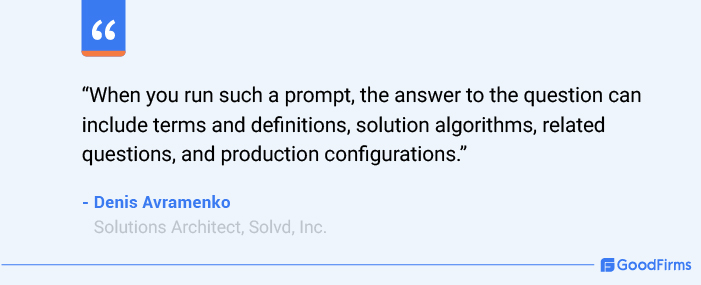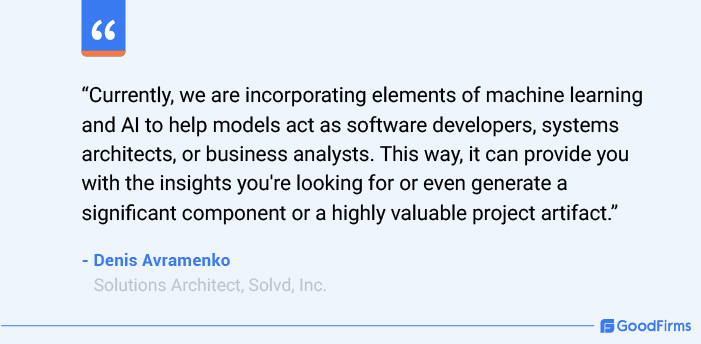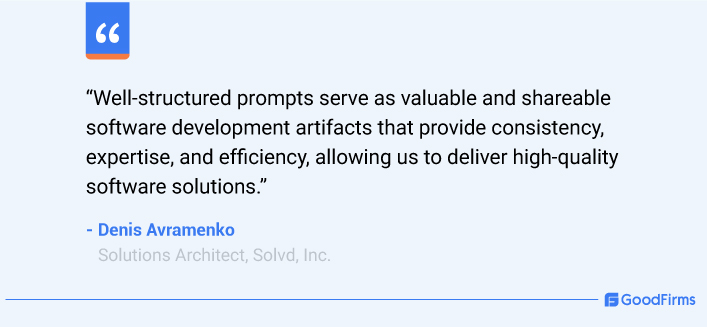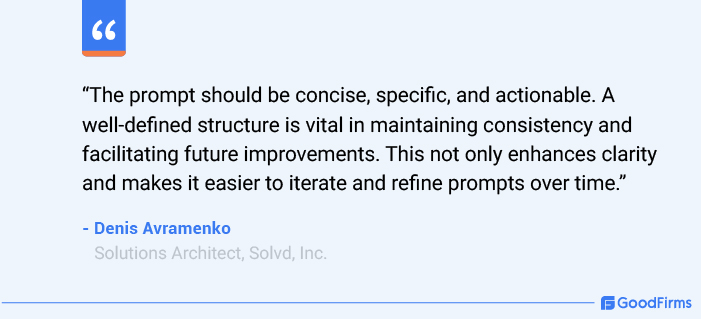ChatGPT and other generative AI tools work on prompts to generate an accurate and relevant response instantly. Rule-based prompts provide greater control over artificial intelligence and involve maximum human intervention. It empowers developers to decrease their dependency on business analysts, optimizes task efficiency, and speeds up and automates workflow processes.
GoodFirms Roundtable is a series of podcast interview discussions where leading industry experts, CEOs, and people holding prominent positions in IT servicing and software companies share their rich experiences and opinions on various topics. The podcast discussion becomes a valuable source of information for budding entrepreneurs willing to start their businesses.
GoodFirms recently had a chance to interview Denis Avramenko, Solutions Architect, Solvd, Inc. in the following podcast discussion will share a plethora of knowledge about the rule-based prompts.
Solvd, Inc. is a top-rated technology consulting firm and a leading software engineering company based in multiple US, South America, and Europe locations. Established in 2011, the company holds expertise in a broad spectrum of services, such as software web development, mobile app development, MVP, QA & software testing, DevOps, AR/VR, and much more. The firm also develops two exclusive products, Zebrunner and MCloud Private Infrastructure.
Critical highlights of this podcast discussion include:
- The problems in software development and ways to mitigate them
- What are rule-based prompts?
- Difference between rule-based prompts and traditional programming and its evolution over the period
- Best scenarios of rule-based prompts to implement
The podcast discussion also focuses on the following crucial points;
- Major industries reaping the benefits of rule-based prompts and their usage.
- Potential drawbacks or limitations to using rule-based prompts in software development and its impact on the accuracy of the final product
- A step-by-step guide to creating rule-based prompts
- How has GoodFirms contributed to the success and growth of Solvd?
Please tell us a little about Solvd and your role within the company
My name is Denis Avramenko, and I’m a Solutions Architect at Solvd. I’ve been working in this company for the last eight years. I’ve tried various roles, like team lead, architect, and head of the development department. For the past four years, I’ve been more focused and committed to primarily working on challenging projects for the past four years. It has allowed me to create multiple development tools and build a deep understanding of software design.

Can you share some of your experience in a project where you have faced problems regarding software development, what was it, and how did you overcome it?
Indeed, we had a project which required creating an integration that could sync entities between two systems and handle errors efficiently.
- First, we had to ensure that the solution was suitable for production use and allowed us to identify the root cause of any synchronization problem quickly.
- Secondly, we had to integrate within a tight timeframe without business analysts. We had to focus on what our users and team needed and expected. It is a great opportunity to combine ChatGPT and our tacit knowledge of software development.
Can you explain the concept of rule-based prompts to our audience?
Denis Avramenko defines rule-based prompts as highly reusable prompts with a specific structure, allowing greater control over the AI output and making it easier to create effective prompts. For instance, a rule-based prompt can instruct the AI to answer a question from a developer in a particular structure and format. You can control the level of detail for each section and emphasize technical aspects.

How do rule-based prompts differ from traditional programming methods? How has it evolved over time?
Traditional programming methods often require developers to start from scratch, while rule-based prompts provide expertise and a starting point. It is fascinating to know that we can essentially tell an AI model to emulate the thought processes and actions of various roles in software development. Also, traditional programming has indeed evolved significantly over time, giving birth to higher levels of abstraction, reusable components, and methodologies that simplify human understanding.

Can you share some examples or scenarios of rule-based prompts that businesses can implement in their software development processes?
One common example is the Requirements Elicitation practice used by business analysts for particularly writing user stories. Such prompts can provide developers with requirements, prepare questionnaires with stakeholders and help create the necessary code for any feature. Another example is building a robust error-handling process. We have designed several rule-based prompts that combine the best practices for integration errors, especially ones that are easily overlooked.

Are there any specific industries or sectors that can benefit the most from using rule-based prompts? Can you give any examples of where it is currently being used?
Rule-based prompts can benefit any industry dealing with software development.
- Game Development
You can use a prompt to create new characters and generate their background story, attributes, and even dialogues based on predefined rules in game development.
- Healthcare
The use of prompts can transform how patient data is analyzed. You can design a prompt to look for specific patterns or markers in the patient data, indicating a potential health issue.
- Customer Service
Here, rule-based prompts are used to generate synthetic data that stimulates different customer interactions.
What are some potential drawbacks or limitations to using rule-based prompts in software development? Does it impact the accuracy and efficiency of the final product?
- One of the potential drawbacks is that rule-based prompts may not always capture the full task complexity.
- They also require careful crafting to ensure accuracy and usefulness.
- If the rules are stringent, they may block your creativity.

Could you please provide a step-by-step guide or best practices for creating rule-based prompts?
Here’s a step-by-step guide to creating rule-based prompts.
- The first step is to understand your task requirements. You must define the exact role of the expert and create a list of artifacts and actions required to finish the task.
- You can start creating a prompt template that will have different sections, such as roles, instructions, rules, and topics. For example, for the business analyst expert creating user stories, you can write in the Role section, ‘Act as a business analyst and follow instructions and provided rules.
- The Instruction section contains artifacts or actions. The task is to craft a user story that describes an interaction between a user and an application in the context of the provided topic.
- In the Rules section, you will add rules that define the format and structure of the response. You must create a markdown document containing three segments, User Story, Acceptance Criteria List, and Stakeholder Questions.
- Each acceptance criterion should follow a specific format and contain several inner sections. Order the items and limit the Acceptance Criteria List to five items.

Could you please share your company's growth journey with GoodFirms and how our platform has contributed to your success?
GoodFirms is a top-notch and highly reliable review and ratings platform. The company has been allowing us to share our experience and expertise with other companies and organizations looking for quality application testing and development services. GoodFirms also provides our existing clients with a viable opportunity to share their impressions of our joint work and the results we achieved together. We are happy to work with GoodFirms.
If you want to listen to this podcast episode, please click here.
What’s Next
ChatGPT and other Generative AI tools are becoming increasingly more advanced and sophisticated with new versions coming up. It has optimized how we give rule-based prompts to generate more specific and accurate responses to accomplish our main objectives. It has helped us quickly create goal-focused user stories, reducing business analysts' involvement and minimizing other technical work. Rule-based prompts also help create project artifacts for technical documentation and mitigate all communication loopholes.
You can share your knowledge or experience on our platform on any topic related to IT services. Just drop an email to [email protected].



